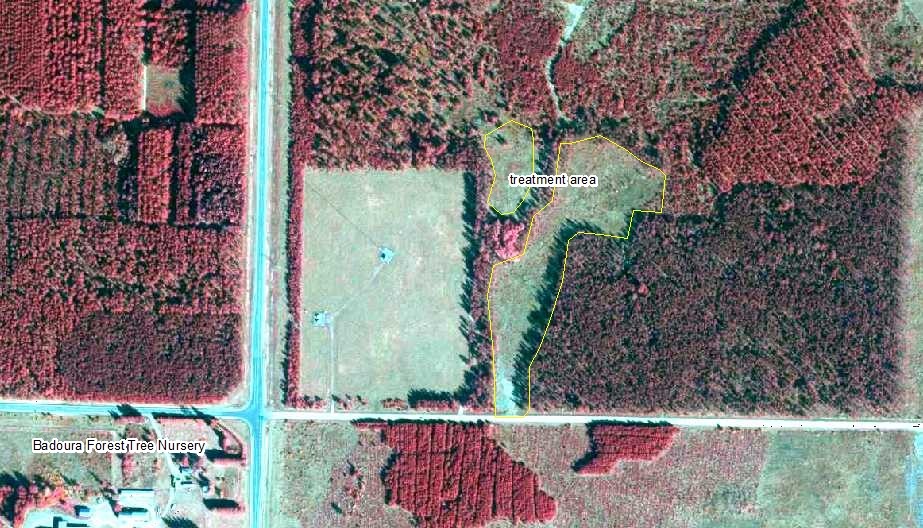Overview
AFMP = Adaptive Forest Management Project. The stand was dominated by jack pine with 25-50% cover. It was appraised at 16 cords/acre. The species/area plot held 63 plant species, including jack pine, northern red oak, eastern white pine, paper birch, red maple, black spruce, red pine, bur oak, tamarack and white spruce. We collected jack pine cones and sent them to the U of MN for diplodia examination. This was one of six sites in an adaptive forest management project testing whether retaining a live seed source would result in adequate natural jack pine regeneration in the Central Floristic Region, where jack pine have a low percentage (0-50%) of serotinous cones.
Silviculture Objective(s)
- Achieve adequate natural regeneration (>300 trees/acre) after harvest by retaining a live seed source on the site
- Maintain a robust Native Plant Community
Pre-treatment stand description and condition
Stand establishment and management history:
This was an apparently natural jack pine stand, probably from fire origin. It had been untouched since establishment.

Figure 1: The stand prior to treatment - 2010.

Figure 2: Typical groundcover pre-treatment - 2010
Silviculture Prescription
Clearcut strips or gaps up to 3 chains (198’) wide during frost-free conditions (for ground scarification). Full tree skid and burn slash or sell biomass. Operate during dry soil conditions. Reserve 3-5 snags/acre. Achieve 300+ jack pines/acre in cut areas via natural seeding from residual jack pines along the edges. If regeneration does not occur, consider additional seedbed treatments (burn, herbicide, mechanical, and/or establish big bluestem).
What actually happened during the treatment
Timber harvest occurred in June, 2011, with the final inspection taking place on 10/3/2015. Dick Walsh Forest Products LLP was the operator. They used a fellerbuncher and grapple skidder. Cutting was completed on June 15 and 16. Skidding and biomass piling occurred during the following week. Biomass was ground up and removed from the site in September, so very little slash remained. Rainfall in September resulted in soil compaction and puddling at the log landing.
Post-treatment assessment
Kellie Wolf (contractor) surveyed eight (1/1000 acre) plots on 6/11/2013 and found no jack pine seedlings. Mike Locke and Harvey Tjader surveyed five (1/1000 acre) plots on 11/4/2014 and found 40% stocking and 400 jack pines/acre. Harvey Tjader and Kara Johnson (intern) surveyed 13 (1/1000 acre) plots on 7/27/2015 and found 1153 jack pines per acre and 53% stocking. We saw jack pine seedlings in the vicinity of all unstocked plots. Stocking was higher on the west side of the harvest strip.
We identified 63 species in a species/area plot prior to treatment in 2010. We identified 51 species after treatment on the same plot in 2013 and 57 species on the same plot in 2015. We realized an apparent loss of 24 species from the plot and an apparent gain of 18 species.

Figure 3: Log landing immediately after sale closure - 2011.

Figure 4: Four years post-treatment, July 2015.

Figure 5: Post-treatment 2012 color infrared aerial.
Plans for future treatments
The site is free to grow, unless deer browsing becomes an issue, which may warrant bud-capping or other deterrents. Young jack pines may start producing cones in another year or two and resulting seed will fill in voids.
Costs and economic considerations
Timber appraisal time was 1-2 days. The timber permit was active for four months (June-Sept 2011), but activity took place during a few days in June and a few in September. The timber sold for $22.18/cord for a total value of $1,996.20 + biomass. Site preparation was achieved through logging during the frost-free season and full tree skidding.
Other notes
This is the only site of our six sites that looks successful at this time. Four of the sites are classified as FDc24 Central Rich Dry Pine Woodland, and vegetative competition on those sites is fierce. The other FDc23 site has poor stocking, and heavy grass competition.
Summary / lessons learned / additional thoughts
The harvest area is about 400’ wide at one point. Stocking in the center of that area is likely to be low until seedlings start producing cones and fill in.
Supplemental Content
Submitted by
Harvey Tjader
Harvey was a staff forester at the MNDNR Northwest Region headquarters in Bemidji, MN. His primary focus was Ecological Land Classification and applications in silviculture. Prior to 2008, he was primarily involved in the timber program. He worked for the Minnesota DNR since he graduated from the University of Minnesota in 1978. Harvey passed away in July of 2022.
